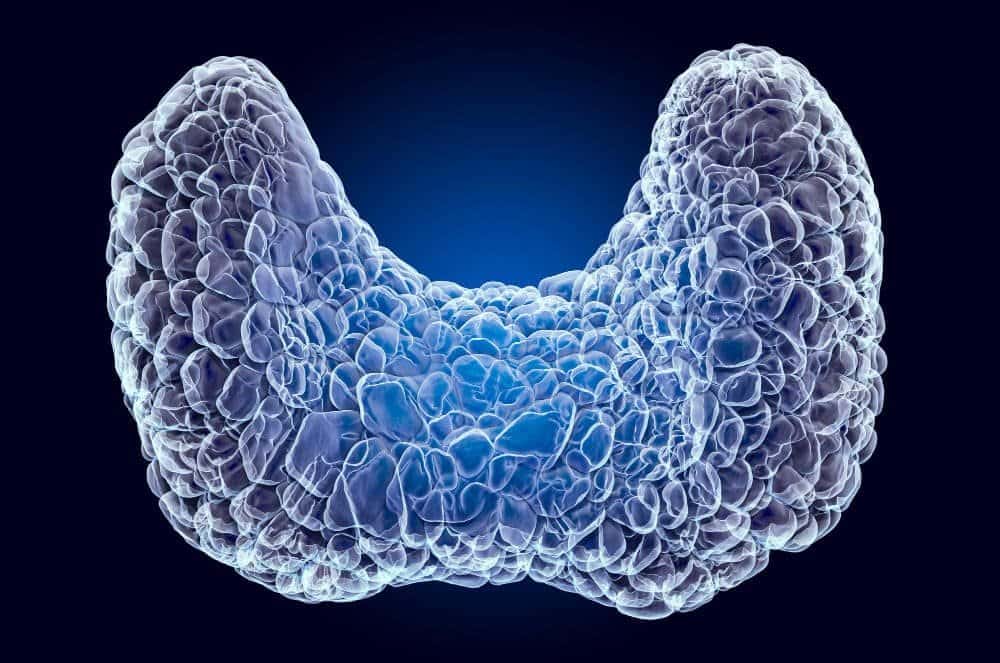Feeling a lump in your neck can be unsettling. Let’s demystify a common reason for this: a multinodular goiter. This detailed guide will walk you through what it is, why it happens, and the advanced, gentle treatment options available to help you feel like yourself again.

What Exactly Is a Multinodular Goiter? 🤔
A multinodular goiter is defined as an enlarged thyroid gland that contains multiple nodules, or lumps. Think of the thyroid gland—a small, butterfly-shaped organ at the base of your neck—as a factory that produces essential hormones for your body’s metabolism. Sometimes, this factory develops distinct growths or nodules within its tissue. When multiple nodules are present and the gland itself swells, it’s called a multinodular goiter (MNG).
Fortunately, the vast majority of these thyroid nodules are benign (noncancerous) and harmless. The condition occurs when an overgrowth of thyroid follicular cells leads to the formation of these lumps. The heterogeneity of these cells means they have different inherent qualities for growth and function, which contributes to the development of a goiter with multiple nodules of varying size and activity.
Goiter vs. Nodular Goiter: Is There a Difference?
The terminology surrounding thyroid disorders can be confusing. Let’s simplify it:
- Goiter: This is a general term that simply refers to any enlargement of the thyroid gland, making the neck look swollen. The gland can be smoothly enlarged (diffuse goiter) or lumpy.
- Nodular Goiter: This specifies that the enlargement is caused by the presence of one or more nodules (lumps). If there’s just one, it’s a solitary nodule. If there are multiple, it’s a multinodular goiter.
This condition is incredibly common; in fact, MNG is the most common cause of goiters and stands as the most prevalent of all thyroid gland disorders worldwide.
Classification & Terminology
To make sense of the different forms, here is how terminology is typically used:
| Term | Meaning / Use |
|---|---|
| Multinodular goiter (MNG) | Enlargement of the thyroid with multiple nodules |
| Nodular goiter | More general term; may be single (uninodular) or multiple |
| Toxic multinodular goiter | A form of MNG where one or more nodules produce excess thyroid hormone, causing hyperthyroidism |
| Non-toxic multinodular goiter | Enlarged, nodular gland with normal thyroid hormone levels |
| Goitre / goiters | Alternative spelling (British English: goitre) |
| Enlarged thyroid / thyroid growth | Descriptive terms to indicate size increase |
In practice, physicians will refer to multinodular goiter, nodular goiter, or differentiate toxic vs nontoxic forms depending on thyroid function.
Unpacking the Causes: Why Does Thyroid Growth Occur?
The exact cause of the goiter isn’t always known, but several factors are strongly linked to the development and apparent acquisition of these cellular growths.
- Iodine Deficiency: Iodine is a crucial building block for thyroid hormone production. When your diet has a lack of iodine, the thyroid gland works harder to produce the hormone it needs, which can cause the cells to multiply and lead to thyroid growth and enlargement. While less common in the United States and other regions with iodized salt, iodine deficiency remains a major cause of goiters in many parts of the world.
- Genetic Factors: There is a clear inheritable component to thyroid disorders. If you have a family history of goiters or thyroid nodules, you may have a genetic predisposition to develop them yourself.
- Autoimmune Disease: Conditions like Hashimoto’s disease can cause inflammation and lead to an enlarged thyroid. This chronic inflammation can contribute to the formation of nodules over time.
- Environmental Factors: Beyond diet, other environmental and lifestyle elements may play a role, though they are less understood.
Recognizing the Signs: Symptoms of an Enlarged Thyroid
Multinodular goiters often grow very slowly and may not cause any symptoms for years. Many are detected incidentally during a routine physical exam or on an imaging test performed for an unrelated reason.
When symptoms do occur, they typically fall into two categories:
- Pressure-Related (Compressive) Symptoms: These result from the physical size of the goiter pressing on other structures in the neck.
- A visible swelling or mass in the neck.
- A feeling of tightness or pressure in the neck, especially when lying down.
- Difficulty swallowing (dysphagia) or a sensation of food getting stuck.
- Hoarseness or changes in your voice.
- Difficulty breathing (dyspnea), particularly when raising your arms above your head (a positive Pemberton’s sign).
- Hormone-Related Symptoms: These appear if the nodules start producing thyroid hormone independently, leading to hyperthyroidism. We’ll explore this next.
The “Toxic” Factor: When a Goiter Produces Excess Hormone 😟
Most multinodular goiters are “non-toxic,” meaning thyroid function remains normal and the gland produces a balanced amount of hormone. However, sometimes one or more nodules can become “autonomous” or “hot.” This means they produce thyroid hormone without responding to the body’s normal signal from the pituitary gland.
When this happens, the condition is called a toxic multinodular goiter. The term “toxic” simply refers to the toxic effects of having too much thyroid hormone (hyperthyroidism) released into thebloodstream. It is the second most common cause of hyperthyroidism after Graves’ disease.
Symptoms of a toxic multinodular goiter include :
- Unexplained weight loss despite an increased appetite.
- A rapid or irregular heartbeat (palpitations).
- Nervousness, anxiety, or irritability.
- Tremors, typically in the hands.
- Increased sensitivity to heat and excessive sweating.
- Fatigue and muscle weakness.
- More frequent bowel movements.
Diagnosis: How Doctors Identify Multinodular Goiters
If you or your doctor suspect a goiter, a systematic evaluation is performed to confirm the diagnosis, check your thyroid function, and assess the nodules.
- Physical Exam: A doctor can often feel the enlarged gland and the presence of multiple lumps by examining your neck.
- Blood Tests: These tests measure the levels of thyroid-stimulating hormone (TSH) and thyroid hormones (T3 and T4) in your blood. This determines if your thyroid is overactive (hyperthyroidism), underactive (hypothyroidism), or functioning normally.
- Thyroid Ultrasound: This is the most important imaging tool. It uses sound waves to create a picture of your thyroid gland, confirming its size, the presence of multiple nodules, and their specific characteristics (like size and whether they are solid or fluid-filled cysts).
- Biopsy (Fine-Needle Aspiration): If any nodule looks suspicious on the ultrasound, a fine-needle aspiration (FNA) biopsy may be recommended. This simple procedure involves using a very thin needle to collect a small sample of cells from the nodule to be checked for cancer.
Beyond “Watch and Wait”: Advanced, Non-Surgical Treatment Options ✨
For many people with a non-toxic, asymptomatic MNG, the recommended course may be simple observation. However, if the goiter is causing compressive symptoms, producing excess hormone, or is cosmetically concerning, treatment is necessary.
While traditional options have included lifelong medication or surgery (thyroidectomy), modern interventional radiology offers groundbreaking, minimally invasive alternatives that preserve the thyroid gland. Dr. Samir Abdel Ghaffar specializes in these cutting-edge techniques, providing effective relief without the need for a scalpel.
1. Radiofrequency Ablation (RFA)
Radiofrequency ablation is a highly effective, minimally invasive procedure for treating benign thyroid nodules. During RFA, a tiny electrode is inserted directly into a thyroid nodule under ultrasound guidance. The electrode emits radiofrequency waves, which generate heat and destroy the targeted nodule tissue, causing it to shrink significantly over time. Studies show RFA provides excellent cosmetic and symptomatic relief, with an average nodule volume reduction rate of over 98% in two years.
Benefits of RFA:
- No Surgery, No Scar: It’s performed in a clinical setting with local anesthesia, leaving no neck scar.
- Preserves Thyroid Function: By only targeting the nodules, the healthy parts of the gland are left intact, avoiding the need for lifelong hormone replacement therapy.
- Quick Recovery: Patients can typically return to their normal activities almost immediately.
2. Microwave Ablation (MWA)
Similar to RFA, microwave ablation is another thermal ablation technique. It uses microwave energy to heat and destroy the nodular tissue. MWA can be particularly effective for larger nodules and offers another excellent option for non-surgical goiter treatment.
3. Thyroid Arterial Embolization (TAE)
Thyroid arterial embolization is another innovative procedure that treats goiters by reducing their blood supply. An interventional radiologist guides a tiny catheter through the bloodstream to the arteries feeding the thyroid gland. Tiny particles are then injected to block these arteries, cutting off the blood and nutrients that the goiter and its nodules need to grow. This causes the entire enlarged gland to shrink, relieving pressure and improving symptoms.
Taking Control of Your Thyroid Health 💪
Discovering you have a multinodular goiter can be concerning, but it is a very manageable condition. With a proper diagnosis, you can understand whether your goiter is affecting your health and explore the best path forward. For patients seeking to avoid surgery and preserve their natural thyroid function, the minimally invasive treatment options offered by interventional radiology represent a major advancement in thyroid care.
If you are dealing with an enlarged thyroid or have been diagnosed with a goiter, consulting with a specialist like Dr. Samir Abdel Ghaffar can provide you with a clear understanding of your condition and access to the most advanced, patient-focused treatments available today.

 العربية
العربية 

